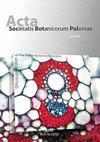Revealing the Core Transcriptome Modulating Plant Growth Phase in Arabidopsis thaliana by RNA Sequencing and Coexpression Analysis of the fhy3 far1 Mutant
IF 0.8
4区 生物学
Q3 PLANT SCIENCES
引用次数: 0
Abstract
Plants must continually calibrate their growth in response to the environment throughout their whole life cycle. Revealing the regularity of plant early growth and development is of great significance to plant genetic modification. It was previously demonstrated that loss of two key light signaling transcription factors, FHY3 and FAR1, can cause a stunted stature in the plant adult stage, and numerous defense response genes can be continuously activated. In this study, we performed a time-course transcriptome analysis of the early 4 weeks of leaf samples from wild plants and their fhy3 and far1 transcription factors. By comparative transcriptome analysis, we found that during the early 4 weeks of plant growth, plants primarily promoted morphogenesis by organizing their microtubules in the second week. In the third week, plants began to trigger largescale defense responses to resist various external stresses. In the fourth week, increased photosynthetic efficiency promoted rapid biomass accumulation. Weighted gene coexpression network analysis of FHY3 and FAR1 revealed that the two light signaling transcription factors may be originally involved in the regulation of genes during embryonic development, and in the later growth stage, they might regulate gene expression of some defense-related genes to balance plant growth and immunity. Remarkably, our yeast two-hybrid and bimolecular fluorescence complementation experiments showed that FAR1 interacts with the immune signaling factor EDS1. Taken together, this study demonstrates the major biological processes occurring during the early 4 weeks of plant growth. The light signaling transcription factors, FHY3 and FAR1, may integrate light signals with immune signals to widely regulate plant growth by directly interacting with EDS1.通过fhy3far1突变体的RNA测序和共表达分析揭示拟南芥中调控植物生长阶段的核心转录组
植物必须在其整个生命周期中不断调整其生长以适应环境。揭示植物早期生长发育规律对植物遗传修饰具有重要意义。先前已经证明,两个关键的光信号转录因子FHY3和FAR1的缺失会导致植物成年期身材发育迟缓,并且许多防御反应基因可以被持续激活。在这项研究中,我们对野生植物叶片样本的前4周及其fhy3和far1转录因子进行了时间过程转录组分析。通过比较转录组分析,我们发现在植物生长的前4周,植物主要通过在第二周组织微管来促进形态发生。在第三周,植物开始引发大规模的防御反应,以抵御各种外部压力。在第四周,光合效率的提高促进了生物量的快速积累。FHY3和FAR1的加权基因共表达网络分析表明,这两种光信号转录因子可能最初参与胚胎发育过程中的基因调控,在生长后期,它们可能调节一些防御相关基因的基因表达,以平衡植物生长和免疫。值得注意的是,我们的酵母双杂交和双分子荧光互补实验表明,FAR1与免疫信号因子EDS1相互作用。总之,这项研究证明了植物生长前4周发生的主要生物学过程。光信号转录因子FHY3和FAR1可以将光信号与免疫信号整合,通过直接与EDS1相互作用来广泛调节植物生长。
本文章由计算机程序翻译,如有差异,请以英文原文为准。
求助全文
约1分钟内获得全文
求助全文
来源期刊
CiteScore
2.00
自引率
10.00%
发文量
18
审稿时长
1 months
期刊介绍:
The journal has been published since 1923 and offers Open Access publication of original research papers, short communications, and reviews in all areas of plant science, including evolution, ecology, genetics, plant structure and development, physiology and biochemistry.

 求助内容:
求助内容: 应助结果提醒方式:
应助结果提醒方式:


